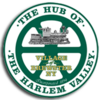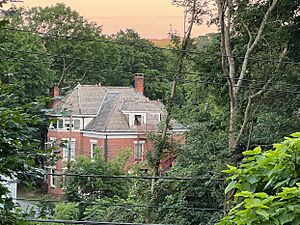Brewster, New York facts for kids
Quick facts for kids
Brewster, New York
|
||
|---|---|---|
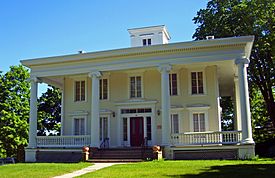
Walter Brewster House
|
||
|
||
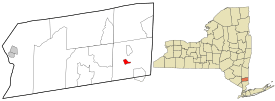
Location in Putnam County and the state of New York.
|
||
| Country | United States | |
| State | New York | |
| County | Putnam | |
| Town | Southeast | |
| Area | ||
| • Total | 0.49 sq mi (1.28 km2) | |
| • Land | 0.49 sq mi (1.27 km2) | |
| • Water | 0.00 sq mi (0.01 km2) | |
| Elevation | 466 ft (142 m) | |
| Population
(2020)
|
||
| • Total | 2,508 | |
| • Density | 5,107.94/sq mi (1,974.01/km2) | |
| Time zone | UTC−5 (Eastern (EST)) | |
| • Summer (DST) | UTC−4 (EDT) | |
| ZIP Code |
10509
|
|
| Area code | 845, 914 | |
| FIPS code | 36-08070 | |
| GNIS feature ID | 0944699 | |
| Website | www.brewstervillage-ny.gov | |
Brewster is a small village in Putnam County, New York. It's the main community within the larger town of Southeast. In 2020, about 2,508 people lived there. The village is named after Walter and James Brewster. They were early farmers who gave land for the railroad station in 1848. Brewster is the most crowded part of Putnam County.
Contents
History of Brewster
The village of Brewster got its name from Walter Brewster. He owned land and invited the New York and Harlem Railroad to build a train station there in 1848. For many years, the area was called "Brewster's Station, New York." It officially became the Village of Brewster in 1894.
In 1886, a historian named William Smith Pelletreau wrote about Putnam County. He explained that the land where Brewster now stands was once a farm. This farm was bought by James and Walter F. Brewster in 1848. They paid $8,000 for about 134 acres.
At that time, the New York and Harlem Railroad was being built. It was planned to go through this area. The Brewster brothers thought it would be a great spot for a train station.
The railroad was finished in Brewster in 1849. A train depot was built, and Main Street was created. This allowed stagecoaches from Danbury to reach the station. Walter F. Brewster built the first new house in the village in 1850. This house is now called the Walter Brewster House. It is a historic building owned by the Landmark Preservation Society of Southeast.
Because the railroad needed to ship building materials, many shipments were simply sent to "Brewster's Station." This is how the village got its name, which was later shortened to Brewster.
Post Offices in Brewster
The first post office in Brewster's Station opened on October 25, 1850. Jonathan F. Frost was the first Postmaster. Back then, post offices were often inside stores.
In 1863, the post office moved to the A.F. Lobdell General Store. This store was across from the railroad station. Alexander F. Lobdell became the Postmaster. He was appointed by President Abraham Lincoln. He stayed in the job until 1887. On April 28, 1883, the post office officially dropped "Station" from its name.
In 1887, the post office moved again. It went into the Brewster Standard newspaper building. Emerson W. Addis, the newspaper's publisher, became the Postmaster. He held the job until 1916.
Over the years, the post office moved several more times. It was in the Rundall Building on Park Street in 1916. Then, in 1927, it moved to the Brewster Bakery plant. In 1936, it moved to a building at 65 Main Street.
In 1966, the post office moved to a new building on Main Street. This was the first building specifically designed to be a post office in Brewster. It had a special lobby for mailboxes and a loading dock.
In the mid-1990s, the Main Street post office closed. A new one opened at 3 Mount Ebo Road North. This new location is outside the village limits. But it still uses the name "Brewster 10509" for its mail.
Brewster vs. Southeast
Before 1962, the town of Southeast had several local post offices. These were near groups of homes and businesses. The last one, the Putnam Lake post office, closed in 1968. When the new post office opened in Brewster in 1966, it was named Brewster. It was given the zip code 10509.
Brewster Crossing Project
For more than ten years, there have been plans to improve the Village of Brewster. In 2011, a study looked at what was causing the community to decline. It found that some properties were not being used well or were falling apart.
These findings led to a plan to rebuild parts of the village. The goal is to turn old or unused buildings into new shops and homes. This will help the local economy grow. It will also encourage people to use the Metro-North Brewster train station.
This project is called Brewster Crossing. Many local people support it. However, some people are against it. This is because the plan involves buying and tearing down some buildings. These buildings might not be unused or falling apart. For example, Bob's Diner, a long-time restaurant, is planned for demolition. Other old buildings, like the Jack & Jill Pool Hall and the A.F. Lobdell estate, are also affected. The project is expected to be finished by 2027.
Geography of Brewster
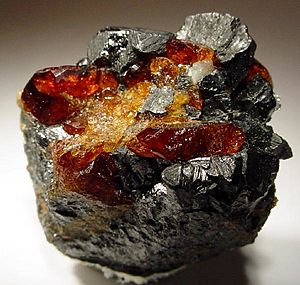
Brewster is located along the East Branch of the Croton River. This is near the center of the town of Southeast. The village is at 41°23′46″N 73°36′57″W / 41.39611°N 73.61583°W.
U.S. Route 6 goes through the village as its Main Street. U.S. Route 202 and New York State Route 22 run along the southern edge of the village. Interstate 84 passes just east of Brewster. It connects with Interstate 684 there. The Brewster train station is on the Harlem Line.
The United States Census Bureau says the village covers about 0.49 square miles (1.28 square kilometers). Almost all of this area is land.
Population Changes
| Historical population | |||
|---|---|---|---|
| Census | Pop. | %± | |
| 1860 | 176 | — | |
| 1900 | 1,192 | — | |
| 1910 | 1,296 | 8.7% | |
| 1920 | 859 | −33.7% | |
| 1930 | 1,664 | 93.7% | |
| 1940 | 1,863 | 12.0% | |
| 1950 | 1,810 | −2.8% | |
| 1960 | 1,714 | −5.3% | |
| 1970 | 1,638 | −4.4% | |
| 1980 | 1,650 | 0.7% | |
| 1990 | 1,566 | −5.1% | |
| 2000 | 2,162 | 38.1% | |
| 2010 | 2,390 | 10.5% | |
| 2020 | 2,508 | 4.9% | |
| U.S. Decennial Census | |||
In 2020, Brewster had 2,508 residents. The village had about 701 homes. Most people living in Brewster were of Hispanic or Latino background (55.98%). About 36.61% were non-Hispanic white. Other groups included African American (2.59%) and Asian (3.22%).
Schools in Brewster
Brewster has several schools for students of all ages.
- Brewster Central School District
- Brewster High School (for older students)
- Henry H. Wells Middle School (for middle schoolers)
- C. V. Starr Intermediate School (for intermediate grades)
- John F. Kennedy Elementary School (for younger students)
- Private schools
- Longview School
- Saint Lawrence O'Toole
Notable People from Brewster
Many interesting people have connections to Brewster.
Athletes
- Mclain Ward (born 1975), a famous horseback rider.
- Shayna Levy (born 1997), an Israeli soccer player.
Entertainers
- Ann Marie (born 1945), an actress.
- Billy Jones (1889–1940), a singer.
- Marian Anderson (1897–1993), a famous singer with a deep voice.
- Glenda Farrell (1904–1971), an actress.
- Herbert Gehr (1910–1983), a TV director and photographer.
- Donald Symington (1925–2013), an actor.
- Ava Fabian (born 1962), a model and actress.
- Joe Rubbo (born 1963), an actor and TV producer.
- Michael Imperioli (born 1966), an actor, writer, TV producer, and musician.
Writers and Artists
- Fanny Crosby (1820–1915), a writer of hymns and an activist for the blind.
- Max Dreyfus (1874–1964), a music publisher and songwriter.
- Edith Diehl (1876–1953), a bookbinder and author.
- Chester Beach (1881–1956), a sculptor.
- Rex Stout (1886–1975), a writer.
- Trude Fleischmann (1895–1990), a photographer.
- Pola Stout (1902–1984), a designer.
- Dorothy Fields (1905–1974), a writer of song lyrics and plays.
- John Bernard Myers (1920–1987), an art dealer and writer.
- Norman Laliberté (1925–2021), an artist.
- Joanne Dobson (born 1942), a novelist.
Media Personalities
- Evelyn Irons (1900–2000), a journalist.
- Diana Vreeland (1903–1989), a famous fashion editor.
Sports Coaches
- Ed Farrell (born 1934), an American football coach.
- Chris Palmer (born 1949), an American football coach.
- Kevin Leighton (born 1979), an American baseball coach and former player.
Military Figures
- Enoch Crosby (1750–1835), an American spy and soldier during the Revolutionary War.
- John McCloy (1875–1945), a Lieutenant Commander in the U.S. Navy and a Medal of Honor winner.
Business Figure
- C.V. Starr(1892-1968), who founded the AIG group.
Images for kids
See also
 In Spanish: Brewster (Nueva York) para niños
In Spanish: Brewster (Nueva York) para niños


